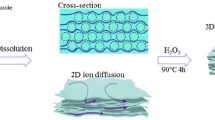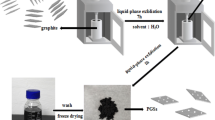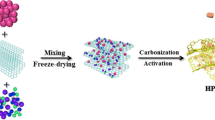Abstract
Unlike activated carbon, graphene sheets are lack of ion pathways on their basal planes and prone to agglomerate or restack unfortunately for their strong π − π interactions between neighboring sheets. All of which will pose significant obstacles for its application in high performance supercapacitors. Herein, we report a simple and fast strategy for the scalable synthesis of hierarchical honeycomb-like porous graphene–carbon nanotubes hybrid (PGCTs) through a simple laser induced self-propagating reaction process and subsequent activation with low amount of KOH without any template. Benefiting from properly integration of large surface area, hierarchical pore structures, in-plane nanopores and CNTs nanospacers, the as-obtained PGCTs based symmetrical supercapacitor exhibits outstanding electrochemical performance with super capacitance, excellent rate capability, and desirable cyclability.

Hierarchical honeycomb-like porous graphene–carbon nanotubes hybrid (PGCTs) has been successfully synthesized by a simple laser induced self-propagating reaction process and subsequent activation with low amount of KOH without any template. The as-obtained PGCTs based symmetrical supercapacitor exhibits outstanding electrochemical performance






Similar content being viewed by others
References
Yoo HD, Markevich E, Salitra G, Sharon D, Aurbach D (2014) On the challenge of developing advanced technologies for electrochemical energy storage and conversion. Mater Today 17:110–121
Simon P, Gogotsi Y, Dunn B (2014) Where do batteries end and supercapacitors begin? Science 343:1210–1211
Zhai Y, Dou Y, Zhao D, Fulvio PF, Mayes RT, Dai S (2011) Carbon materials for chemical capacitive energy storage. Adv Mater 23:4828–4850
Simon P, Gogotsi Y (2008) Materials for electrochemical capacitors. Nat Mater 7:845–854
Kotz R, Carlen M (2000) Principles and applications of electrochemical capacitors. Electrochim Acta 45:2483–2498
Liu C, F Li, Ma LP, Cheng HM (2010) Advanced materials for energy storage. Adv Mater 22:28–62
Béguin F, Presser V, Balducci A, Frackowiak E (2014) Carbons and electrolytes for advanced supercapacitors. Adv Mater 26:2219–2251
Winter M, Brodd RJ (2004) What are batteries, fuel cells, and supercapacitors? Chem Rev 104:4245–4270
Chen J, Li C, Shi GQ (2013) Graphene materials for electrochemical capacitors. J Phys Chem Lett 4:1244–1253
Stoller MD, Park S, Zhu Y, An J, Ruoff RS (2008) Graphene-based ultracapacitors. Nano Lett 8:3498–3502
Sun YQ, Wu Q, Shi GQ (2011) Graphene based new energy materials. Energy Environ Sci 4:1113–1132
Kuila T, Mishra AK, Khanra P, Kim NH, Lee JH (2013) Recent advances in the efficient reduction of graphene oxide and its application as energy storage electrode materials. Nanoscale 5:52–71
Zhu YW, Murali S, Stoller MD, Velamakanni A, Piner RD, Ruoff RS (2010) Microwave assisted exfoliation and reduction of graphite oxide for ultracapacitors. Carbon 48:2118–2122
El–Kady MF, Strong V, Dubin S, Kaner RB (2012) Laser scribing of high-performance and flexible graphene-based electrochemical capacitors. Science 335:1326–1330
Liu CG, Yu Z, Neff D, Zhamu A, Jang BZ (2012) Graphene-based supercapacitor with an ultrahigh energy density. Nano Lett 10:4863–4868
Wang HB, Maiyalagan T, Wang X (2012) Review on recent progress in nitrogen-doped graphene: synthesis, characterization, and its potential applications. ACS Catal 2:781−794
Yang X, Zhu J, Qiu L, Li D (2011) Bioinspired effective prevention of restacking in multilayered graphene films: towards the next generation of high-performance supercapacitors. Adv Mater 23:2833–2838
Xu ZW, Li Z, Holt CMB, Tan XH, Wang HL, Amirkhiz BS, Stephenson T, Mitlin D (2012) Electrochemical supercapacitor electrodes from sponge-like graphene nanoarchitectures with ultrahigh power density. J Phys Chem Lett 3:2928–2933
Huang Y, Liang JJ, Chen YS (2012) An overview of the applications of graphene-based materials in supercapacitors. Small 8:1805–1834
Yu DS, Goh KL, Wang H, Wei L, Jiang WC, Zhang Q, Dai LM, Chen Y (2014) Scalable synthesis of hierarchically structured carbon nanotube-graphene fibres for capacitive energy storage. Nat Nanotechnol 9:555–562
Qiu L, Yang X, Gou X, Yang W, Ma ZF, Wallace GG, Li D, (2010) Dispersing carbon nanotubes with graphene oxide in water and synergistic effects between graphene derivatives. Chem Eur J 16:10653–10658
Fan Z, Yan J, Zhi L J, Zhang Q, Wei T, Feng J, Zhang ML, Qian WZ, Wei F (2010) A Three - Dimensional carbon nanotube/graphene sandwich and its application as electrode in supercapacitors. Adv Mater 22:3723–3728
Cheng HH, Dong ZL, Hu CG, Zhao Y, Hu Y, Qu LT, Chen N, Dai LM (2013) Textile electrodes woven by carbon nanotube–graphene hybrid fibers for flexible electrochemical capacitors. Nanoscale 5:3428–3434
Yang SY, Chang KH, Tien HW, Lee YF, Li SM, Wang YS, Wang JY, Ma CC, Hu CC (2011) Design and tailoring of a hierarchical graphene-carbon nanotube architecture for supercapacitors. J Mater Chem 12:2374–2380
Yu D, Dai L (2010) Self-assembled graphene/carbon nanotube hybrid films for supercapacitors. J Phys Chem Lett 1:467–470
Wang ZL, Xu D, Wang HG, Wu Z, Zhang XB (2013) In situ fabrication of porous graphene electrodes for high-performance energy storage. ACS Nano 7:2422–2430
Zhu YW, Murali S, Stoller MD, Ganesh KJ, Cai WW, Ferreira PJ, Pirkle A, Wallace RM, Cychosz KA, Thommes M, Su D, Stach EA, Ruoff RS (2011) Carbon-based supercapacitors produced by activation of graphene. Science 332:537–1541
Jiang ZJ, Jiang ZQ, Weiheng Chen WH (2014) The role of holes in improving the performance of nitrogen-doped holey graphene as an active electrode material for supercapacitor and oxygen reduction reaction. J Power Sources 251:55–65
Jiang LL, Sheng LZ, Long CL, Fan ZJ (2015) Nano Energy 11:471–480
Wang JC, Kaskel S (2012) KOH activation of carbon-based materials for energy storage. J Mater Chem 22:23710–23725
Marcano DC, Kosynkin DV, Berlin JM, Sinitskii A, Sun ZZ, Slesarev A (2010) Improved synthesis of graphene oxide. ACS Nano 4:4806–4814
Wang DW, Min YG, Yu YH, Peng B (2014) Laser induced self-propagating reduction and exfoliation of graphite oxide as an electrode material for supercapacitors. Electrochim Acta 141:271–278
Wang DW, Wang QH, Wang TM (2011) Morphology-controllable synthesis of cobalt oxalates and their conversion to mesoporous Co3O4 nanostructures for application in supercapacitors. Inorg Chem 50:6482–6492
Jain A, Tripathi SK (2013) Converting eucalyptus leaves into mesoporous carbon for its application in quasi solid-state supercapacitors. J Solid State Electrochem 17:2545–2550
Stoller MD, Ruoff RS (2010) Best practice methods for determining an electrode material’s performance for ultracapacitors. Energy Environ Sci 3:1294–1301
Zhang SL, Pan N (2015) Supercapacitors performance evaluation. Adv Energy Mater 5:1401401
Vickery JL, Patil A J, Mann S (2009) Fabrication of graphene–polymer nanocomposites with higher-order three-dimensional architectures. Adv Mater 21:2180–2184
Wang DW, Min YG, Yu YH (2015) Facile synthesis of wheat bran-derived honeycomb-like hierarchical carbon for advanced symmetric supercapacitor applications. J Solid State Electrochem 19:577–584
Su DS, Perathoner S, Centi G (2013) Nanocarbons for the development of advanced catalysts. Chem Rev 113:5782-5816
Gu W, Yushin G, (2014) Review of nanostructured carbon materials for electrochemical capacitor applications: advantages and limitations of activated carbon, carbide-derived carbon, zeolite-templated carbon, carbon aerogels, carbon nanotubes, onion-like carbon, and graphene. WIREs Energy Environ 3:424–473
Sing KSW, Everett DH, Haul RAW, Moscou L, Pierotti RA, Rouquerol J, Siemieniewska T (1985) Reporting physisorption data for gas/solid systems with special reference to the determination of surface area and porosity. Pure & Appl Chem 57:603–619
Kiani MA, Khani H, Mohammadi N (2014) MnO2/ordered mesoporous carbon nanocomposite for electrochemical supercapacitor. J Solid State Electrochem 18:1117–1125
Wang DW, Fang GL, Xue T, Ma JF, Geng GH (2016) A melt route for the synthesis of activated carbon derived from carton box for high performance symmetric supercapacitor applications. J Power Sources 307:401–409
Zhang LL, Zhou R, Zhao XS (2010) Graphene-based materials as supercapacitor electrodes. J Mater Chem 20:5983–5992
Frackowiak E, Be´guin F (2001) Carbon materials for the electrochemical storage of energy in capacitors. Carbon 39:937–950
Yan J, Wang Q, Wei T, Fan ZJ (2014) Recent advances in design and fabrication of electrochemical supercapacitors with high energy densities. Adv Energy Mater 4:1300816
Niu ZQ, Liu LL, Zhang L, Chen XD (2014) Porous graphene materials for water remediation. Small 10:3434–3441
Acknowledgments
The authors are grateful to the financial supports from the National Natural Science Foundation of China (Grant no. 21303257, 51561001 and 61440051), and National Undergraduate Innovation and Entrepreneurship Training Programs (Grant no. 201611407002).
Author information
Authors and Affiliations
Corresponding author
Rights and permissions
About this article
Cite this article
Wang, D., Fang, G., Zheng, Q. et al. Construction of hierarchical porous graphene–carbon nanotubes hybrid with high surface area for high performance supercapacitor applications. J Solid State Electrochem 21, 563–571 (2017). https://doi.org/10.1007/s10008-016-3403-4
Received:
Revised:
Accepted:
Published:
Issue Date:
DOI: https://doi.org/10.1007/s10008-016-3403-4




